WORLD CLASS COACHING
40 Fun Games For Young Players
By Luca Bertolini
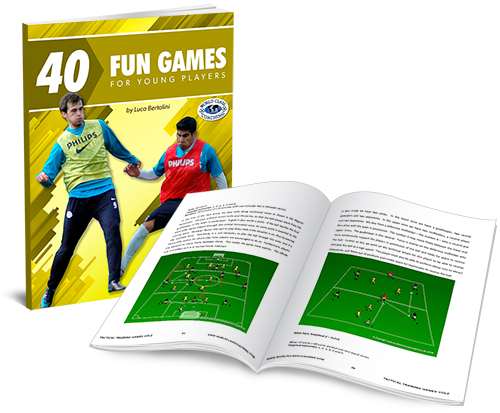
Table of Contents
PART FOUR
Fun Games
Fun Games
Exercise 29: 1 v 1 multiple duels (1)
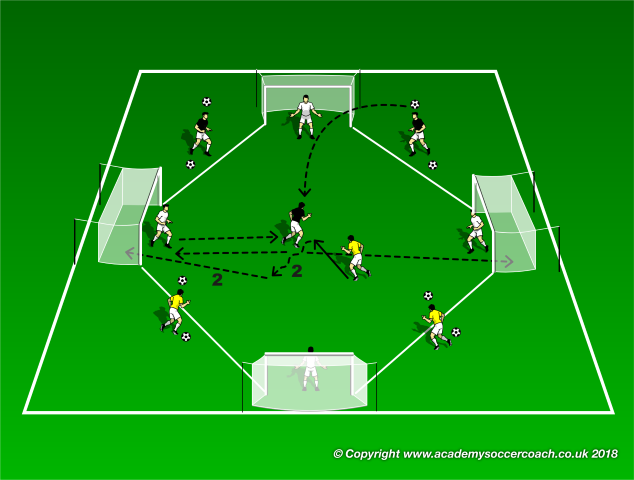
Set-up and sequence: this exercise is a progression of the exercise num.28. 4 goals with goalkeepers and 2 black and 2 yellow players with 2 balls each are placed on the corners and along the sides of a diamond set-up, as in the picture. A 1 v 1 duel is played in the middle between the black attacker and the yellow defender; both them can finish 4 times (shooting toward all the goals) and must defend 4 times, after receiving a volley pass from the outer teammates, playing a wall pass combination with a goalkeeper and finishing toward the opposite goal (2). The attacker must be properly positioned to receive and for a header control first and then to finish after receiving the return pass. The defender must clear the chances for the opponent by deciding if to counter the first pass or the return pass from a goalkeeper. If the defender wins the ball, he can shot toward the nearest and easiest goal. The round ends when all the 3 players of each team have played 1 turn as attacker and 1 turn as defender.
Coaching points: body positioning to finish with 1 touch, escape the marker, aerial receiving skills, mark the man on, save the goal space.
Exercise 30: 1 v 1 multiple duels (2)
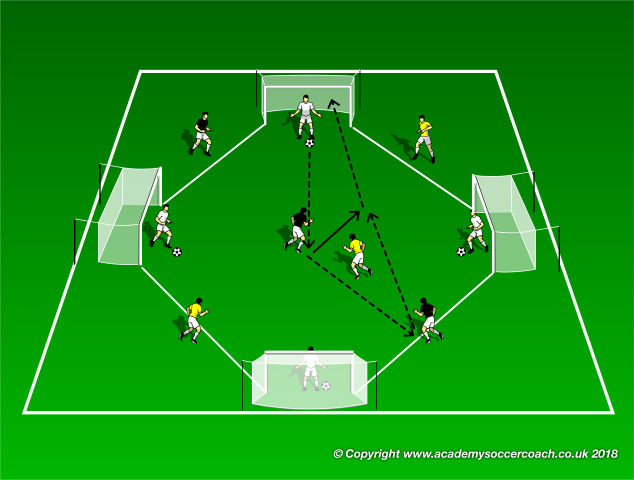
Set-up and sequence: this exercise is another progression of the exercise num.28. 4 goals with goalkeepers in possession and 2 black and 2 yellow players (in front of each other) are placed on the corners and along the sides of a diamond set-up, as in the picture. A 1 v 1 duel is played in the middle between the black attacker and the yellow defender; both them can finish 4 times (shooting toward all the goals) and must defend 4 times, after receiving a pass from a goalkeeper, playing a wall pass combination with the opposite outer teammates and finishing toward the goal, where the ball was received from at the beginning. The attacker must be properly positioned to receive. The defender must clear the chances for the opponent by deciding if to counter the first pass or the second return pass. The round ends when all the 3 players of each team have played 1 turn as attacker and 1 turn as defender.
Coaching points: body positioning to finish with 1 touch, pass quickly to free from the opposition pressure, escape the marker, mark the man on, save the goal space.
Exercise 31: dribbling and feints battle
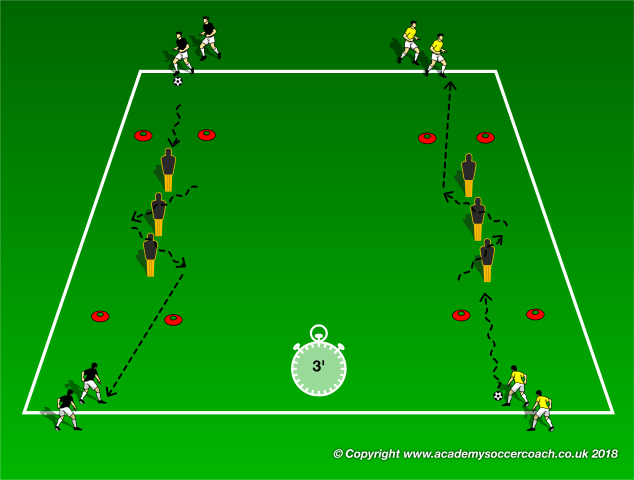
Set-up and sequence: 2 teams of 4 players (or whatever is the number of the available players, but even number if possible) are placed and lined as in the picture. 3 air-bodies stand in the middle between the team's queues. The teams must dribble the ball out and back, feinting among the air-bodies; the team that completes the highest number of turns within 3', wins the round. Dribbling and feinting must be performed as required by the coach. Every final pass must be played between the red cones; otherwise, the turn doesn't count.
Coaching points: dribbling quality and speed, feinting quickness, quality of ball touches.
Exercise 32: dribbling, feinting and shooting battle
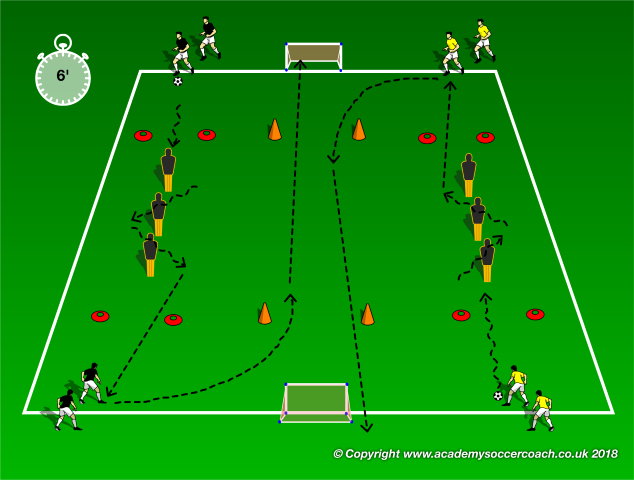
Set-up and sequence: 2 teams of 4 players (or whatever is the number of the available players, but even number if possible) are placed and lined as in the picture. 3 air-bodies stand in the middle between the team's queues. 2 mini-goals are placed in the middle of the end lines, as in the picture. The teams must dribble the ball toward the opposite side, feinting among the air-bodies; the players in possession must pass the ball between the red cones and the receiver must control it toward the opposite mini-goal, in front of them and sideways from the center orange cones, before shooting on goal. The turn can be considered valid only if they score; otherwise, the turn doesn't count. The player who kicked the ball must recover the ball to start a new sequence. The team who completes the highest number of turns (scoring goals) within 6’ wins the round.
Coaching points: dribbling quality and speed, feinting quickness, quality of ball touches, shooting accuracy.
Exercise 33: dribble from the nation to the continent and score in the capitol city
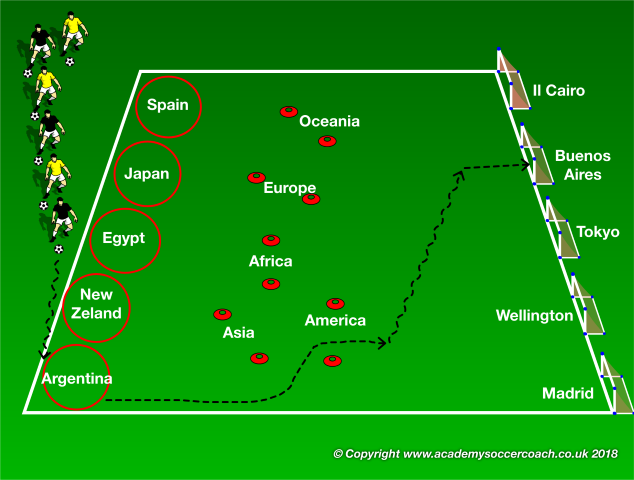
Set-up and sequence: 2 teams of 3 players (or whatever is the number of the available players, but even number) are placed and lined alternately, as in the picture. The playing area is set-up as follow:
• The cycles at the beginning are named as Nations.
• The cones' gates in the middle are named as Continents.
• The mini-goals along the opposite side are named as Capitol cities of the Nations.
The coach calls out the cycle where to start from and the player must connect it with the correct continent first and then score in the right mini-goals.
After a fixed number of repetitions, the total time of both teams has to be signalled and the faster team in completing the connections wins the round. The players must dribble the ball with the foot and in the ways the coach requires.
Variation: the coach can call out the Continent first that must be connected with the right Nation and then with the right Capitol city, to encourage changes of direction while dribbling the ball.
Coaching points: dribbling quality and speed, proper changes of directions, quality of ball touches, shooting accuracy.
Exercise 34: throw-ins battle
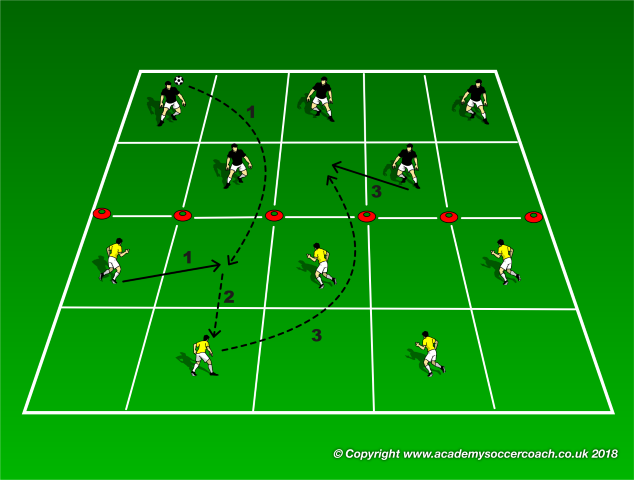
Set-up and sequence: 2 teams of 5 players each are placed on a pitch that is divided into 2 halves. Each half is then again divided into 8 parts and the players must be placed alternately in a 3-2 or 2-3 formation, as in the picture; one team starts with the ball possession. The goal when the team is possession is to play throw-ins toward a free space of the opposition's half, trying to let the ball touch the ground; the defending team must prevent this, moving a player toward that part of the pitch and catching the ball in the air (1). When the ball is safe, a second player must receive the ball (2) to send another throw-in toward the opposite side (3), moving across the half to keep the required formation; all the other players must move the same way. If the ball touches the ground a point is gained. When the formation is not correctly shaped, that team loses a point. After a fixed limit of time, the leading team wins the round.
Note: the throw-ins must be always properly performed to win the potential point.
Variation: the ball can be saved by a correct foot aerial control inside the area where the ball is falling; but it can't go out of it.
Coaching points: alternate short and long throw-ins, throw-ins technical skills.
Exercise 35: dribbling checkers game
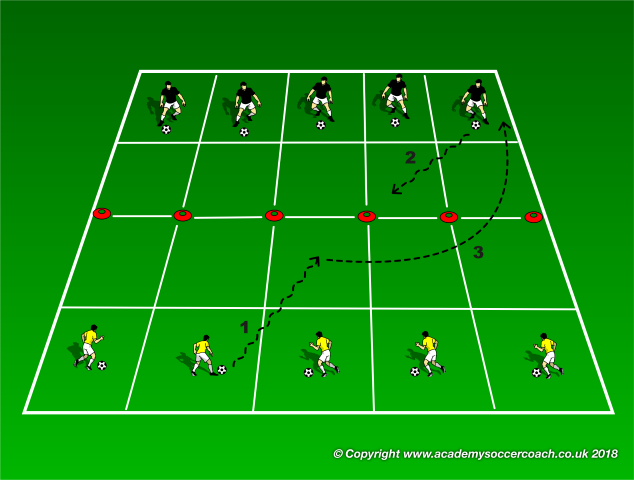
Set-up and sequence: 2 teams of 5 players (all them have a ball) each are placed on pitch that is divided into 2 halves. Each half is then again divided into 10 parts and all the players must be placed along the lower parts of each half, as in the picture. The goal of the game is the same of the checkers one, but dribbling the ball. A first player starts, dribbling the ball diagonally on the left or on the right (1) and the same does another one on the other side (2); the goal is to overcome the opponent behind him to gain a point as to crown a draught. The first team that crowns 3 draughts wins the round. Dribble must be performed as required by the coach.
Coaching points: dribbling quality and speed, proper dribbling directions, quality of ball touches.
Exercise 36: dribbling along the rivers
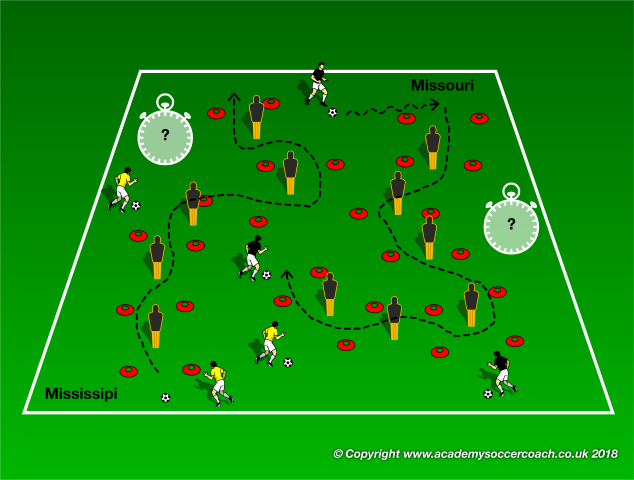
Set-up and sequence: 2 teams of 3 players (or whatever is the number of the available players, but even number if possible) are placed inside a rectangular playing area, as in the picture. 2 cones' rivers are marked inside the area with air-bodies in the middle and between the cone's set-ups. Each team is linked to a specific "river" at every repetition. When the coach sends a sign (a whistle as instance), the nearest player of each team to the river's spring must start sailing it among the air-bodies. The team who is able to sail both the river within the fewest limit of time wins the round. The dribble must be performed as the coach requires.
Coaching points: dribbling quality and speed, feinting quickness, quality of ball touches.
Exercise 37: face the goals
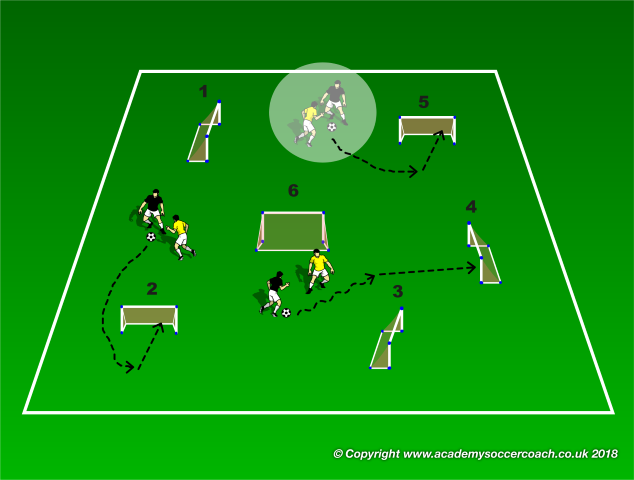
Set-up and sequence: 2 teams of 3 players each are placed and paired in multiple 1 v 1 duels inside a rectangular pitch. 6 goals are placed and numbered all around the pitch in random directions (1 - 6). The players exchange the possession of the ball under semi-active pressure until the sign of the coach, who calls "even!" or "odd!”. The players in possession must try to dribble the ball toward the goals that are even or odd numbered, to score a goal for their team; the defenders must try to counter them and to score in the same kind of mini-goal (if a defender saved an odd numbered mini-goal, he must score in a another odd mini-goal).
Variations:
• The defenders must score in an opposite kind of mini-goal; if he saved an odd numbered mini-goal, he must score in an even numbered mini-goal.
• The defenders must score in the exact opposite mini-goal; if he saved the mini-goal num.3, he must score in the num.1.
Coaching points: dribbling quality, proper dribbling directions, quality of ball touches, reaction to play in a fully active way, mark the opponent on, force the opponent away from the goal.
Exercise 38: dribbling through the storm
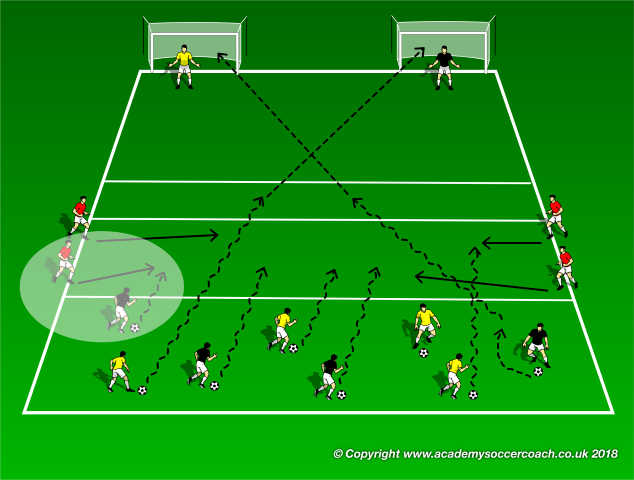
Set-up and sequence: a rectangular area is divided into 4 parts. 2 teams of 4 players with the ball each are placed in the lower area, 4 more players without possession are placed along the sidelines of the next area, a smaller shooting zone is the third one and the last one is used to create a distance between the shooting area and the goals that are placed along the upper end line. The players dribble freely at the beginning until the sign of the coach (a whistle, as instance), when they must carry the balls toward the shooting area, dribbling through the second area, where the 4 red players try to counter them to win the possession. The players who can dribble through must try to finish toward the opposition goal (goalkeepers switch teams at every new sequence) inside the shooting area. If a red player is able to recover the ball, the roles of the teams must be switched (the team of the player who lost the possession becomes defending team, the red team becomes one of the attacking team). The team with the highest number of goals after a fixed number of repetitions wins the round.
Coaching points: dribbling quality at speed, proper dribbling directions, quality of ball touches, counter the opponent by tackling, force the opponent away from the goal direction.
Exercise 39: score following the compass (1)
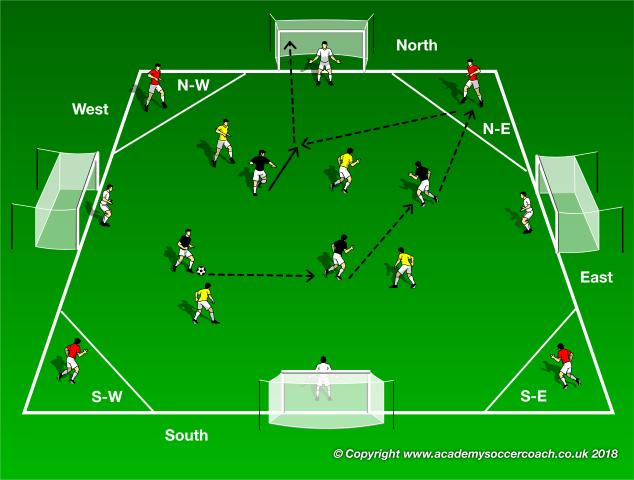
Set-up and sequence: a hexagon set-up is marked inside the rectangular main playing space, as in the picture. The 4 sides of the rectangle are considered as cardinal points (the goals with goalkeepers are placed in the center of these cardinal points) and the triangles that are shaped on the corners by the main rectangle and the internal hexagon are the intermediate cardinal points, where 4 free players are placed. A 4 v 4 duel is played in the middle of the smaller set up; at the beginning is a possession game, but when the coach indicates the "cardinal points goals" where the possession team must score, the move must be finished after a wall passing combination with the one of the neutral players, who are placed on the intermediate cardinal points. All the 4 possession players must have touched the ball once before finishing. If the defending team recovers the possession, the move must be finished toward the opposite "cardinal point goal". After a fixed limit of time, the role of neutral player must be exchanged, and the team with the highest number of scored goals wins the round.
Coaching points: speed of play, reaction speed to direct the attacking phase, forces the possession phase of the opposition sideways.
Exercise 40: score following the compass (2)
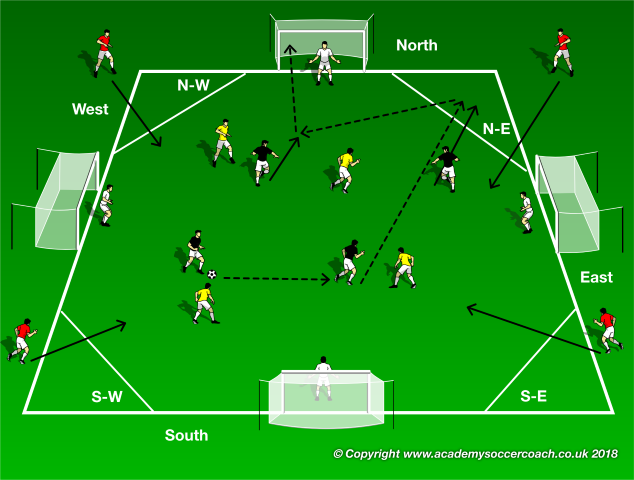
Set-up and sequence: a hexagon set-up is marked inside the rectangular main playing space, as in the picture. The 4 sides of the rectangle are considered as cardinal points (the goals with goalkeepers are placed in the center of these cardinal points) and the triangles that are shaped on the corners by the main rectangle and the internal hexagon are the intermediate cardinal points. A 4 v 4 duel is played in the middle of the smaller set up; at the beginning is a possession game; when the coach indicates the "cardinal points goals" where the possession team must score, the move must be finished after a wall passing combination with the one player of the possession team who escape the marker in the middle to be ready to receive inside the intermediate cardinal point space. All the 4 possession players must have touched the ball once before finishing. If the defending team recovers the possession, the move must be finished toward the opposite "cardinal point goal" by the same way. The attacking team becomes defending team as 1 goal is scored; a third team (the red one) becomes attacking team and the last one runs out to wait for the next turn.
Variation: after a fixed limit of time, the red players become defenders, creating numerical advantage to recover the possession; the team who wins the ball become the attacking team during the next sequence.
Coaching points: speed of play, reaction speed to direct the attacking phase, forces the possession phase of the opposition sideways.


